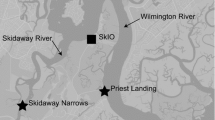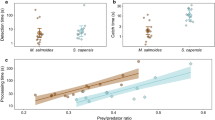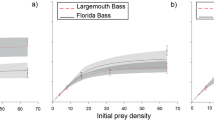Abstract
Predator body size often indicates predation risk, but its significance in non-consumptive effects (NCEs) and predator risk assessment has been largely understudied. Although studies often recognize that predator body size can cause differing cascading effects, few directly examine prey foraging behavior in response to individual predator sizes or investigate how predator size is discerned. These mechanisms are important since perception of the risk imposed by predators dictates behavioral responses to predators and subsequent NCEs. Here, we evaluate the role of predator body size and biomass on risk assessment and the magnitude of NCEs by investigating mud crab foraging behavior and oyster survival in response to differing biomasses of blue crab predators using both laboratory and field methods. Cues from high predator biomass treatments including large blue crab predators and multiple small blue crab predators decreased mud crab foraging and increased oyster survival, whereas mud crab foraging in response to a single small blue crab did not differ from controls. Mud crabs also increased refuge use in the presence of large and multiple small, but not single small, blue crab predators. Thus, both predator biomass and aggregation patterns may affect the expression of NCEs. Understanding the impact of predator biomass may therefore be necessary to successfully predict the role of NCEs in shaping community dynamics. Further, the results of our laboratory experiments were consistent with observed NCEs in the field, suggesting that data from mesocosm environments can provide insight into field situations where flow and turbulence levels are moderate.





Similar content being viewed by others
References
Anholt BR, Werner E, Skelly DK (2000) Effect of food and predators on the activity of four larval ranid frogs. Ecology 81:3509–3521. doi:10.1890/0012-9658(2000)081[3509:EOFAPO]2.0.CO;2
Benoit HP, Swain DP (2008) Impacts of environmental change and direct and indirect harvesting effects on the dynamics of a marine fish community. Can J Fish Aquat Sci 65:2088–2104
Berry WA (2009) A hydrodynamic characterization of tidal ecosystems with respect to predation. MS thesis, Georgia Insititute of Technology, Atlanta
Bisker R, Castagna M (1987) Predation on single spat oysters Crassostrea virginica by blue crabs Callinectes sapidus and mud crabs Panopeus herbstii. J Shellfish Res 6:37–40
Bolnick DI, Preisser EL (2005) Resource competition modified the strength of triat-mediated predator-prey interactions: a meta-analysis. Ecology 86:2771–2779. doi:10.1890/04-1249
Breitburg DL, Palmer MA, Loher T (1995) Larval distributions and the spatial patterns of settlement of an oyster reef fish: responses to flow and structure. Mar Ecol Prog Ser 125:45–60. doi:10.3354/meps125045
Chivers DP, Mirza RS, Bryer PJ, Kiesecker JM (2001) Threat-sensitive predator avoidance by slimy sculpins: understanding the importance of visual versus chemical information. Can J Zool 79:867–873
Cohen JE, Pimm SL, Yodzis P, Saldana J (1993) Body sizes of animal predators and animal prey in food webs. J Anim Ecol 62:67–78
Crumrine PW (2005) Size structure and substitutability in an odonate intraguild predation system. Oecologia 145:132–139. doi:10.1007/s00442-005-0084-6
Darimont CT, Carlson CM, Kinnison MT, Paquet PC, Reimchen TE, Wilmers CC (2009) Human predators outpace other agents of trait change in the wild. PNAS 106:952–954. doi:10.1073/pnas.0809235106
Dodson SI (1970) Complementary feeding niches sustained by size-selective predation. Limnol Oceanogr 15:131–137
Eggleston DB (1990) Functional responses of blue crabs Callinectes sapidus feeding on juvenile oysters Crassostrea virginica (Gmelin)—effects of predator sex and size, and prey size. J Exp Mar Biol Ecol 143:73–90. doi:10.1016/0022-0981(90)90112-P
Engqvist L (2005) The mistreatment of covariate interaction terms in linear model analyses of behavioural and evolutionary ecology studies. Anim Behav 70:967–971. doi:10.1016/j.anbehav.2005.01.016
Ferner MC, Smee DL, Weissburg MJ (2009) Habitat complexity alters lethal and non-lethal olfactory interactions between predators and prey. Mar Ecol Prog Ser 374:13–22. doi:10.3354/meps07764
Ferrari MCO, Wisenden BD, Chivers DP (2010) Chemical ecology of predator-prey interactions in aquatic ecosystems: a review and prospectus. Can J Zool 88:698–724. doi:10.1139/Z10-029
Fitz HC, Weigert RG (1991) Utilization of the intertidal zone of a salt marsh by the blue crab Callinectes sapidus: density, return frequency, and feeding habits. Mar Ecol Prog Ser 76:249–260
Forrester GE (1994) Influences of predatory fish on the drift dispersal and local density of stream insects. Ecology 75:1208–1218
Gibbons MC, Castagna M (1985) Biological control of predation by crabs in bottom cultures of hard clams using a combination of crushed stone aggregate, toadfish, and cages. Aquaculture 47:101–104. doi:10.1016/0044-8486(85)90056-0
Grabowski JH (2004) Habitat complexity disrupts predator-prey interactions but not the trophic cascade on oyster reefs. Ecology 85:995–1004. doi:10.1890/03-0067
Grabowski JH, Kimbro DL (2005) Predator avoidance behavior extends trophic cascades to refuge habitats. Ecology 86:1312–1319. doi:10.1890/04-1216
Grabowski JH, Hughes AR, Kimbro DL (2008) Habitat complexity influences cascading effects of multiple predators. Ecology 89:3413–3422. doi:10.1890/07-1057.1
Griffen BD, Byers JE (2006a) Partitioning mechanisms of predator interference in different habitats. Oecologia 146:608–614. doi:10.1007/s00442-005-0211-4
Griffen BD, Byers JE (2006b) Intraguild predation reduces redundancy of predator species in multiple predator assemblage. J Anim Ecol 75:959–966. doi:10.1111/j.1365-2656.2006.01115.x
Hill JM (2011) Predator biomass and habitat characteristics affect the magnitude of consumptive and non-consumptive effects (NCEs): experiments between blue crabs, mud crabs, and oyster prey. PhD dissertation. Georgia Insititute of Technology, Atlanta
Hollebone AL, Hay ME (2007) Propagule pressure of an invasive crab overwhelms native biotic resistance. Mar Ecol Prog Ser 342:191–196. doi:10.3354/meps342191
Kats LB, Dill LM (1998) The scent of death: chemosensory assessment of predation risk by prey animals. Ecoscience 5:361–394
Kusch RC, Mirza RS, Chivers DP (2004) Making sense of predator scents: investigating the sophistication of predator assessment abilities of fathead minnows. Behav Ecol Sociobiol 55:551–555. doi:10.1007/s00265-003-0743-8
Lee SY, Kneib RT (1994) Effects of biogenic structure on prey consumption by the xanthid crabs Eurytium limosum and Panopeus herbstii in a salt marsh. Mar Ecol Prog Ser 104:39–47
Leonard LA, Luther ME (1995) Flow hydrodynamics in tidal marsh canopies. Limnol Oceanogr 40:1474–1484
Lima SL (1998) Non-lethal effects in the ecology of predator prey interactions. Bioscience 48:25–34
Lima SL, Bednekoff PA (1999) Temporal variation in danger drives antipredator behavior: the predation risk allocation hypothesis. Am Nat 153:649–659
Lipcius RN, Stockhausen WT (2002) Concurrent decline of the spawning stock, recruitment, larval abundance, and size of the blue crab Callinectes sapidus in Chesapeake Bay. Mar Ecol Prog Ser 226:45–61. doi:10.3354/meps226045
McIntosh AR, Peckarsky BL, Taylor BW (2004) Predator-induced resource heterogeneity in a stream food web. Ecology 85:2279–2290. doi:10.1890/03-0196
Micheli F (1997) Effects of predator foraging behavior on patterns of prey mortality in marine soft bottoms. Ecol Monogr 67:203–224. doi:10.1890/0012-9615(1997)067[0203:EOPFBO]2.0.CO;2
Miller LP, Gaylord B (2007) Barriers to flow: the effects of experimental cage structures on water velocities in high energy subtidal and intertidal environments. J Exp Mar Biol Ecol 344:215–228. doi:10.1016/j.jembe.2007.01.005
Newell RIE (2004) Ecosystem influences of natural and cultivated populations of suspension feeding bivalve molluscs: a review. J Shellfish Res 23:51–61
Nowell ARM, Jumars PA (1984) Flow environments of aquatic benthos. Annu Rev Ecol Syst 15:303–328
O’Connor NE, Grabowski JH, Ladwig LM, Bruno JM (2008) Simulated predator extinctions: predator identity affects survival and recruitment of oysters. Ecology 89:428–438. doi:10.1890/06-2029.1
Orth RJ, van Montfrans J (1987) Utilization of a seagrass meadow and tidal marsh creek by blue crabs Callinectes sapidus I. Season and annual variations in abundance with emphasis on post settlement juveniles. Mar Ecol Prog Ser 41:283–294
Peckarsky BL, Abrams PA, Bolnick DI, Dill LM, Grabowski JH, Luttbeg B, Orrock JL, Peacor SD, Preisser EL, Schmitz OJ, Trussel GC (2008) Revisiting the classics: considering nonconsumptive effects in textbook examples of predator-prey interactions. Ecology 89:2416–2425. doi:10.1890/07-1131.1
Powers SP, Kittinger JN (2002) Hydrodynamic mediation of predator-prey interactions: differential patterns of prey susceptibility and predator success explained by variation in water flow. J Exp Mar Biol Ecol 273:171–187. doi:10.1016/S0022-0981(02)00162-4
Preisser EL, Bolnick DI, Benard MF (2005) Scared to death? The effects of intimidation and consumption in predator-prey interactions. Ecology 86:501–509. doi:10.1890/04-0719
Rochette R, Dill LM, Himmelman JM (1997) A field test of threat sensitivity in a marine gastropod. Anim Behav 54:1053–1062. doi:10.1006/anbe.1997.0488
Rudolf VHW (2006) The influence of size-specific indirect interactions in predator-prey systems. Ecology 87:362–371. doi:10.1890/05-0961
Schmitz OJ (2008) Effects of predator hunting mode on grassland ecosystem functioning. Science 319:952–954. doi:10.1126/science.1152355
Schmitz OJ, Suttle KB (2001) Effects of top predator species on direct and indirect interactions in a food web. Ecology 82:2072–2081. doi:10.1890/0012-9658(2001)082[2072:EOTPSO]2.0.CO;2
Schmitz OJ, Krivan V, Ovadia O (2004) Trophic cascades: the primacy of trait mediated indirect interactions. Ecol Lett 7:153–163. doi:10.1111/j.1461-0248.2003.00560.x
Schoeppner NM, Relyea RA (2005) Damage, digestion, and defence: the roles of alarm cues and kairomones for inducing prey defences. Ecol Lett 8:505–512. doi:10.1111/j.1461-0248.2005.00744.x
Schoeppner NM, Relyea RA (2008) Detecting small environmental differences: risk-response curves for predator-induced behavior and morphology. Oecologia 154:743–754. doi:10.1007/s00442-007-0862-4
Seed R (1980) Predator-prey relationships between the mud crab Panopeus herbstii, the blue crab Callinectes sapidus and the atlantic ribbed mussel Geukensia demissa. Estuar Coast Mar Sci 11:445–458
Shackell NL, Frank KT, Fisher JAD, Petrie B, Leggett WC (2010) Decline in top predator body size and changing climate alter trophic structure in an oceanic ecosystem. Proc R Soc Lond B 277:1353–1360. doi:10.1098/rspb.2009.1020
Smee DL, Ferner MC, Weissburg MJ (2008) Alteration of sensory abilities regulates the spatial scale of nonlethal predator effects. Oecologia 156:399–409. doi:10.1007/s00442-008-0995-0
Smee DL, Ferner MC, Weissburg MJ (2010) Hydrodynamic sensory stressors produce nonlinear predation rates. Ecology 91:1391–1400. doi:10.1890/09-0017.1
Stankowich T, Blumstein DT (2005) Fear in animals: a meta-analysis and review of risk assessment. Proc R Soc Lond B 272:2627–2634. doi:10.1098/rspb.2005.3251
Trussel GC, Ewanchuck PJ, Bertness MD (2002) Field evidence of trait mediated indirect interactions in a rocky intertidal food web. Ecol Lett 5:241–245. doi:10.1046/j.1461-0248.2002.00304.x
Trussel GC, Ewanchuk PJ, Matassa CM (2006) Habitat effects on the relative importance of trait and density mediated indirect interactions. Ecol Lett 9:1245–1252. doi:10.1111/j.1461-0248.2006.00981.x
Turner AM, Fetterolf SA, Bernot RJ (1999) Predator identity and consumer behavior: differential effects of fish and crayfish on the habitat use of a freshwater snail. Oecologia 118:242–247. doi:10.1007/s004420050724
Van Buskirk J, Arioli M (2002) Dosage response of an induced defense: how sensitive are tadpoles to predation risk? Ecology 83:1580–1585. doi:10.1890/0012-9658(2002)083[1580:DROAID]2.0.CO;2
Weissburg MJ (2000) The fluid dynamical context of chemosensory behavior. Biol Bull 198:188–202
Werner EE, Gilliam JF (1984) The ontogenetic niche and species interactions in size-structured populations. Annu Rev Ecol Syst 15:393–425
Werner EE, Peacor SD (2003) A review of trait mediated indirect interactions in ecological communities. Ecology 84:1083–1100. doi:10.1890/0012-9658(2003)084[1083:AROTII]2.0.CO;2
Wilson ML (2011) Sensory landscape impacts on odor-mediated predator-prey interactions at multiple spatial scales in salt marsh communities. PhD dissertation, Georgia Institute of Technology, Atlanta
Zar JH (1999) Biostatistical analysis, 4th edn. Prentice Hall, Upper Saddle River
Zimmer RK, Zimmer CA (2008) Dynamic scaling in chemical ecology. J Chem Ecol 34:822–836. doi:10.1007/s10886-008-9486-3
Acknowledgments
The authors would like to thank Miranda Wilson, Kristine Schaffer, and Nicholas Brantley for their assistance in the laboratory and the field and Lee Smee for loaning us ADVs to make flow comparisons. We would also like to acknowledge the Skidaway Institute of Oceanography and its staff for being wonderful hosts. We also appreciate comments from C. Peterson and two anonymous reviewers whose suggestions improved this manuscript. This work was funded by National Science Foundation (NSF) grant NSF-OCE #0424673 to MJW and the NSF Integrative Graduate Education and Research Traineeship (IGERT) Fellowship in aquatic chemical ecology.
Author information
Authors and Affiliations
Corresponding author
Additional information
Communicated by Pete Peterson.
Rights and permissions
About this article
Cite this article
Hill, J.M., Weissburg, M.J. Predator biomass determines the magnitude of non-consumptive effects (NCEs) in both laboratory and field environments. Oecologia 172, 79–91 (2013). https://doi.org/10.1007/s00442-012-2488-4
Received:
Accepted:
Published:
Issue Date:
DOI: https://doi.org/10.1007/s00442-012-2488-4




